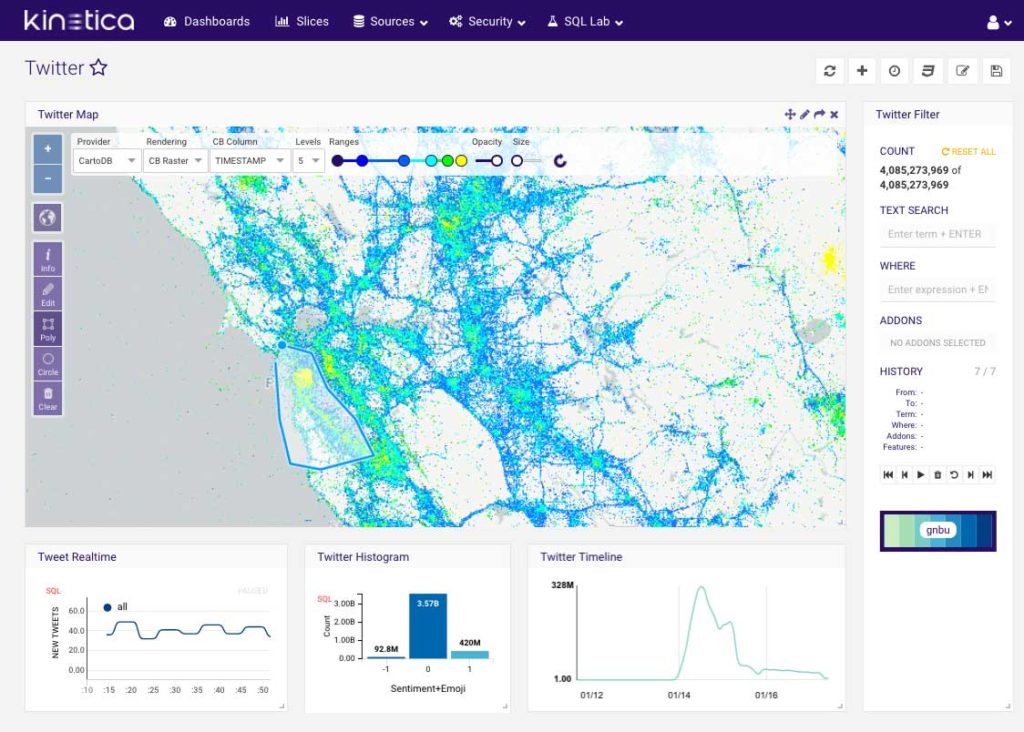Today we’re pleased to announce that Kinetica has closed a $50M Series A funding round. With the increased investment, we seek to further expand our solution capabilities while broadening the adoption of Kinetica – a next-generation database platform for analytics and AI accelerated by GPUs. Kinetica remains uniquely positioned to support global enterprises as they seek to get more value from large and streaming datasets at the fastest speed possible.
We started working on a GPU-accelerated database back in 2009, after seeing first hand the challenges in processing large streaming datasets of the U.S. Intelligence community. Since then, Kinetica has evolved to become the fastest commercially-available database platform for computing complex analytical and machine learning workloads. Kinetica’s ability to ingest millions to billions of records per minute and simultaneously process data across thousands of cores, across multiple GPU cards, and across multiple machines, is truly remarkable. Customers have typically seen 10 to 100 times performance improvements over comparable CPU-bound systems, sometimes with only 1/10th the hardware.
Customers are realizing game-changing benefits from Kinetica at a fraction of the cost. Enterprises now demand instant access to information to drive projects such as personalized offers, social media sentiment analysis, and cyber-security anomaly detection. Customers are able to improve the performance of their Tableau and Power BI dashboards – reducing their load and query times from several minutes to seconds. This opens new opportunities to explore data in ways that were previously unthinkable. Analysts can slice and dice data without waiting, and discover patterns within data that might have gone unnoticed with large streaming datasets.
And it’s more than just speed: Kinetica brings together familiar relational database and SQL semantics, with complex geospatial capabilities, visualization, in-database processing, and machine learning at scale.
Geospatial analytics is an area where enterprises are reaping tremendous benefits from Kinetica. GPU acceleration lends itself well to the analysis of massive geospatial datasets with millions or billions of objects. Kinetica natively supports points, lines, and complex polygon features using open standards, and comes with an end-to-end visualization pipeline capable of rendering large results on interactive maps. Users can view incredible detail, filter location data by arbitrary boundaries, and drill in and explore data without delay. Where, before, geospatial systems might only be capable of rendering hundreds, or perhaps thousands, of geospatial features for a given query, with Kinetica users can see the full picture.

We’re also excited to see how customers are putting Kinetica to work to operationalize machine learning and deep learning models. Over the last six months, we’ve opened our API for custom in-database processing. Now, instead of moving data out to specialized data science environments, customers can bring their algorithms to a centralized source of truth with the latest up-to-date data. Furthermore, this same API exposes mechanisms to make such algorithms available to business users straight from their BI tools.
As the machine learning ecosystem develops and matures, Kinetica is providing a flexible data layer for training models, while also serving those models to end users. In recent months, TensorFlow has gained so much traction with our customers that it is now included as part of our latest Kinetica release.
Our commitment to customer success ultimately drives our ambition of an enduring company: one that can exploit the benefit of first-mover advantage, while continuing to listen to what the market says and needs. We are thrilled to be doing so with such an experienced and passionate team of employees and investors.
It is rare to find venture capitalists that have strong database backgrounds, as the community is so small. We are humbled to have three of the industry’s best be a part of our company and sit on our board. They include Ray Lane, who served as President and COO at Oracle for eight years; Gary Little, a Co-Founder and General Partner at Canvas Ventures, who funded TimesTen during its early venture round; and Paul Madera, Co-Founder and Managing Director at Meritech, who invested in Netezza and Greenplum. We also have the pleasure of having Ramneek Gupta, Managing Director & Co-Head of Venture Investing at Citi Ventures sit as a board observer and broaden our reach to the financial sector. What excites our investors is how broadly applicable Kinetica is, and how it will be used by companies in the future in ways that we can’t begin to fathom today.
We are delighted by the strong support from our partners, including NVIDIA for accelerated hardware; cloud partners Amazon, Microsoft and Google, all of whom now offer GPU instances; and Cisco, Confluent, Dell, HP, IBM, Fuzzy Logix, Safe Software, ESRI, Supermicro, and Tableau, among others.
These are transformative times for data processing. For enterprises who want to profit from rapid decisions using the totality of their data – from sensors in cars, behavior from customers, signals in banking systems, patterns from medical devices – our broadly applicable GPU-accelerated database will power the future of analytical and AI applications.
We are proud to transition to the next phase of growth of our company with this investment.

